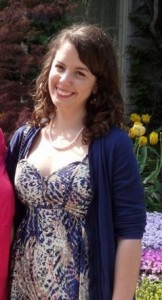Current Location: Washington, D.C.
Current Gig: Web content producer, Kiplinger’s Personal Finance
Member Since: June 3, 2011
Six-word memoir: A little bit Moleskin, a little bit Web 2.0
Favorite fictional character: It’s not particularly highbrow, but I’m going to go with “The O.C.‘s” Seth Cohen.
Favorite Tech Tool: I’m really into Tableau right now. It’s a free data visualization software that creates pretty sophisticated interactives without any development work.
What happens during your average day?
I don’t feel like I have an average day – in general, the only consistency is that I need a second cup of coffee promptly at 2 p.m. I usually have a list of five to six projects that I’m working on at any given time. They range from loading magazine content to researching apps to writing slideshows to wrangling spreadsheets for data visualizations to coding basic infographics and interactives. So generally I just work my way through my projects, go to meetings, and meet periodically with a senior editor to check in on progress.
There is less deadline pressure at Kiplinger than at a news site, so I’m given time to develop ideas and try new things.
Why did you choose to get involved with online media?
I don’t know if I ever made a definitive choice – I just always really liked the Internet. I started a mortifyingly angsty Livejournal when I was 13 and kept working online since then. I think it always appealed to me that on the Internet, you make your own rules. Print magazines have space constraints and ad page quotas and a limited set of tools and forms. Online, anything is possible.
What led you to create Salt, the iPad-based magazine?
I originally wanted to work on an iPad project because I’d seen the Wired app and was totally floored by all the stuff it could do. When magazine apps first came out, they seemed so magical and Harry Potter-esque – you could touch a screen and all these crazy things would happen. As we got into conceptualizing the project, though (and it was very much a collaborative project, with my friends Kuan Luo and Brian Dawson), we were motivated by a very different idea – that we kind of hated reading most iPad magazines, and nothing looked native to the platform, and the focus on “interactive” gimmicks felt sort of childish and condescending. So the goal of Salt became “let’s design a magazine that allows a different kind of reading experience, one designed specifically for the iPad.”
What are the challenges involved in creating an iPad-based magazine?
I think the main struggle is always conceptual: answering the question “why are we doing this?” or “what value does this convey to my reader?” Sometimes it seems like people skip this step or default to the conventional wisdom or put an app out because it’s expected they have one. But if there’s not a really outstanding vision behind your app, it shows in the finished product.
So both when I was working on Salt and now that I’m pitching apps for work, I find myself doubting and interrogating the reasoning behind my ideas more or less all the time.
What was the process involved, from inception to publication, for TK, your crowdsourced, 48-hour time limit magazine project?
It was hectic! At the very end of the year, a few days before graduation, my friend Kuan and I spontaneously decided that we wanted to try this project to celebrate the end of school. We both love Longshot and thought it could work on a smaller scale, too. So we started a Twitter and a Tumblr and a Facebook and invited all our friends to this event and put up some posters and that kind of thing.
We camped out in one of the computer labs and hoped someone would submit. They did, thankfully! We were in the computer lab for something like 18 hours, reading stories and laying out the zine. Then we moved to the library to print and bind it. And then … we passed out. We’re working on a second issue now.
How does it feel to be starting your career while big media is breaking down? Where do you see pitfalls and where do you see opportunities?
I’m really excited about it. I’m not an expert, by any means, but I feel like the “breakdown” of big media has created amazing opportunities for young journalists. It’s flattened the hierarchy. I am sometimes sort of amazed that I get to do cool stuff at work – I mean, I’m 22. In Devil-Wears-Prada world, I should still be getting someone coffee. And that’s true of all my friends: Because they have this innate understanding of the web, they’re starting blogs and building web apps and running social media accounts for pretty major organizations. And the ones at small organizations are doing even cooler things, because there’s an appreciation for agility and creativity and new ideas. The dreaded “digital revolution” seems more meritocratic to me — it’s more about doing good work than paying your dues. For a young journalist, at least, there are no pitfalls to that situation.
If you had a million dollars dedicated to improving media, you would …
Yikes. I would probably start some kind of scholarship fund for interns, because the whole college-student-as-slave-labor phenomenon troubles me. Barring that, I’d donate to the Knight News Challenge.


